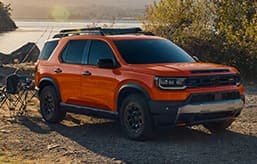1886 Benz Patent Motorwagen First Drive Review
It may look like a three-wheeled park bench, but this is the genesis for the modern automobile
Who invented the first automobile?
In 1886, Karl Benz, the German inventor of the first stationary gasoline engine, filed a patent for the Benz Patent Motorwagen, a small internal-combustion-powered vehicle that's widely considered to be the first automobile as we know it today. It's about as basic as motorized transportation gets, but the 1886 Benz Patent Motorwagen offers a truly singular experience, and not just because it lacks a steering wheel. It's loud, crude and terribly inefficient yet utterly and completely charming. In that way, the first car paved the way for so many of our favorite cars that have come along since.
When was the first automobile made?
The first automobile was made in Germany in 1885, with the patent for the design filed later, on January 29, 1886. In 1888 Karl Benz began selling and reproducing the Patent Motorwagen after his wife, Bertha, proved the viability and use case when she made a 66-mile journey that started in Mannheim, Germany, and ended in her maternal hometown. Bertha wasn't alone; her two sons accompanied her in seats mounted to the front wheel. She made the return trip just a few days later, stopping at stores along the way to purchase ligroin.
What is the Benz Patent Motorwagen?
Personal self-propelled transportation. Put more simply, it's an alternative to walking or horse-drawn carriage and not much more. There's a padded bench seat that's barely wide enough for two adults. The floor is made from wood, and the frame is steel tubing. The wheels — and there are only three of them — are wrapped in solid rubber (and are, therefore, technically run-flat) tires. Behind and below you is the engine. It's mounted directly to the frame, so every single vibration is felt right through the seat. There's brass everywhere. The suspension is basically what would be found on a cart or carriage. There's no instrument cluster. There's no radio. It doesn't even have pedals. It simply runs using hand controls and hope.
When compared to its contemporary alternatives, the Patent Motorwagen has a lot going for it. Horses need to be fed. They get sick, too, and, at the end of the day, are conscious creatures that don't always have to listen to what you say. Few things are more frustrating than when your horse won't start. The train only takes you from station to station. The car goes everywhere. Sure, there are modes of transport that also don't produce manure and aren't limited to rail, but do you really want to be seen riding a penny-farthing bike over pockmarked dirt roads?
That said, the horse bit of the horse-drawn carriage is a helpful driver aid, and you can arrange them in rows to increase towing and hauling capacity. The railroad is quicker and more reliable and has the advantage of requiring little effort beyond handing over a ticket and finding a seat.
What's under the first automobile's hood?
The Patent Motorwagen doesn't have a hood per se — this doorless mid-engine spyder's motor is exposed to the elements. The 1.0-liter four-stroke single-cylinder engine makes roughly 0.75 horsepower at about 400 rpm. Neither one of those last two figures is a typo. It's water-cooled, too, though the evaporative (rather than recirculating) cooling system needs to be constantly refilled with water. There is no fuel tank or fuel pump; you simply fill the carburetor with 4.5 liters of fuel. The fuel itself isn't gasoline but a petroleum product called ligroin that should be available at your local chemist (likely located across the road from a haberdashery or apothecary).
The heavy flywheel is about the size of an extra-large pizza. Prime the air-fuel mixture by giving the flywheel a little tug. There's a little hiss as the fluid moves. You have to spin it to get the engine going, but if it's not spun hard enough, it could snap back with enough force to break a wrist. Get it right, and it sputters to life. Its single spark plug fires at such a slow rate that the engine sounds like it might stall at any second.
How does the first automobile drive?
It's actually very simple to operate. There's a large lever on the left-hand side of the car; push it forward to accelerate and pull it back to slow down. You steer the lone front wheel via a handle mounted right in the center. That's it. No pedals. No shifter. No speedometer to tell you how fast you're going and no fuel gauge to tell you when you're running low. Just drive until the carburetor or the evaporative cooling system runs dry.
Push the lever forward to engage the single-speed transmission. The handle moves a leather belt from an open gear to a drive gear. That, in turn, rotates chains attached to each rear wheel. With less than a single horsepower on tap, the Patent Motorwagen moves with big "I haven't had my coffee yet" energy. The car creeps off the line as the engine starts to speed up, each pop coming a little sooner than the last as the revs continue to build. Eventually, it settles into a steady series of putts.
Once moving, you can essentially run at wide open throttle, though full throttle is only good for about 18 mph. Barely neighborhood speeds but much quicker than walking. The Patent Motorwagen's lackadaisical demeanor goes for both accelerating and braking. The brakes themselves are made from shoe leather, so it's a good thing there's not a ton of mass to slow down. The car moves slowly enough that there's plenty of time to avoid obstacles or navigate a turn.
Turning may be the oddest thing about driving the Patent Motorwagen. The steering column hadn't been invented yet, so there's no steering wheel. Instead, it uses a vertical handle that you move left and right. Steering the car's front wheel is much more akin to turning a bicycle than an automobile. Honestly, a bicycle handlebar would be much easier to use, but that would require two hands. There's a reason why autos of every ilk use a combination of hand and foot controls.
It doesn't take long to figure out how to smoothly accelerate, brake, and turn. The controls are extremely simple, and as long as you're aware of the physics involved with a three-wheeled vehicle, steering becomes easier. Simply put, slow down in a straight line, and don't turn too quickly. You sit very high up, and the sensation that you might topple over at any second never really goes away. Using the lever feels natural, if unusual.
The lack of a windshield (or windows or roof) isn't really a problem. If you can handle the wind in your face while riding a bicycle, you can handle the Benz. There is no safety equipment either. Your feet serve as the crumple zone, and the chance of being tossed from the car in a collision is high since there's no restraint to keep you in place. We would also avoid driving at night as there's no lighting of any sort on the vehicle.
Our drive was done with an expert and caretaker from the Mercedes-Benz Classic Center in the passenger seat. It's snug with two adults, so be sure you've made friends with your traveling partner, as you two will be quite cozy. While the top speed wouldn't change, the car would likely feel quicker and slow down easier with just a single occupant.
Slow as it is, the Patent Motorwagen is thrilling to drive. It's charming in its own simplicity. Maybe it's because you can see it all working, but there's a surprising directness to the inputs. It's all there in the open, including much of the engine. Poke your head down there and you can watch parts move up and down, oil dripping as it all turns in motion. You can see exactly how the steering and drive gear work. Nothing is hidden.
When was the first gasoline-powered American automobile made?
More important than the Patent Motorwagen itself is everything that's come after. Literally, millions and millions more followed in its wake. It's not hard to see why it took off. It would be another seven years before America would see its own car, the Duryea Motor Wagon. The first American automobile was made in 1893, when two brothers, Charles and Frank Dureyea, installed a gas engine on an old horse buggy in Springfield, Massachusetts. Later it would be Henry Ford who mass-produced the Model T. It all started with the Patent Motorwagen, and it's not hard to see why. Crude and simplistic as it may be today, the Patent Motorwagen was revolutionary when it debuted. For the equivalent of several thousand dollars today, you could have a mode of transport that didn't require constant attention and feeding.











 by
by  edited by
edited by